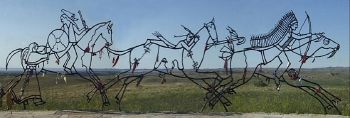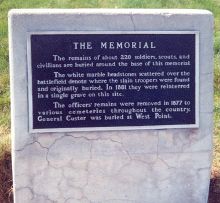Little Bighorn Battlefield National Monument
| Little Bighorn Battlefield National Monument | |
|---|---|
| IUCN Category III (Natural Monument) | |
| | |
| Location: | Big Horn County, Montana, USA |
| Nearest city: | Billings, Montana |
| Area: | 765.34 acres (3,097,200 m²) |
| Established: | January 29, 1879 |
| Visitation: | 328,668 (in 2005) |
| Governing body: | National Park Service |
Little Bighorn Battlefield National Monument preserves the site of the June 25, 1876 Battle of the Little Bighorn, near Crow Agency, Montana, in the United States. It also serves as a memorial to those who fought in the battle: George Armstrong Custer's 7th Cavalry and a combined Lakota-Northern Cheyenne and Arapaho force. Custer National Cemetery, on the battlefield, is part of the national monument. The site of a related military action led by Marcus Reno and Frederick Benteen is also part of the national monument, but is about 3 miles (5 km) southeast of the Little Bighorn battlefield.
Background
The Battle of the Little Bighorn—also known as Custer's Last Stand, and, in the parlance of the relevant Native Americans, the Battle of the Greasy Grass—was an armed engagement between a Lakota-Northern Cheyenne combined force and the 7th Cavalry of the United States Army. It occurred between June 25 and June 26, 1876, near the Little Bighorn River in the eastern Montana Territory.
The battle was the most famous action of the Indian Wars, and was a remarkable victory for the Lakota and Northern Cheyenne, led by Sitting Bull. A sizeable force of U.S. cavalry commanded by Lieutenant Colonel George Armstrong Custer was defeated; Custer himself was killed in the engagement along with two of his brothers. It was, however, not the highest infliction of casualties by Native Americans against U.S. forces, which occurred in the 1791 Battle of the Wabash.
Memorial site
The site was first preserved as a national cemetery by the Secretary of War on January 29, 1879, to protect graves of the 7th Cavalry troopers buried there. Proclaimed National Cemetery of Custer's Battlefield Reservation to include burials of other campaigns and wars on December 7, 1886. The name has been shortened to "Custer National Cemetery," and although it had been the site of Custer's grave, he was reinterred to West Point Cemetery in 1877.
Reno-Benteen Battlefield was added on April 14, 1926. Transferred from the War Department to the National Park Service on July 1, 1940. Redesignated Custer Battlefield National Monument on March 22, 1946. Listed on the National Register of Historic Places on October 15, 1966.[1] The site was renamed Little Bighorn Battlefield National Monument by a law signed by President George H. W. Bush on December 10, 1991.
The site was first preserved as a national cemetery in 1879, to protect graves of the 7th Cavalry troopers buried there. It was redesignated Custer Battlefield National Monument in 1946, and later renamed Little Bighorn Battlefield National Monument in 1991.
Memorialization on the battlefield began in 1879 with a temporary monument to U.S. dead. This was replaced with the current marble obelisk in 1881. In 1890 the marble blocks that dot the field were added to mark the place where the U.S. cavalry soldiers fell. The bill that changed the name of the national monument also called for an Indian Memorial to be built near Last Stand Hill. On Memorial Day 1999, two red granite markers were added to the battlefield where Native American warriors fell. As of December 2006, there are now a total of ten warrior markers (three at the Reno-Benteen Defense Site, seven on the Custer Battlefield).[2]
Memorials
The first memorial on the site was assembled by Captain George Sanderson and the 11th Infantry. They buried soldiers' bodies where they were found and removed animal bones. In his official report dated April 7, 1879, Sanderson wrote:
I accordingly built a mound out of cord wood filled in the center with all the horse bones I could find on the field. In the center of the mound I dug a grave and interred all the human bones that could be found, in all, parts of four or five different bodies. This grave was then built up with wood for four feet above ground. The mound is ten feet square and about eleven feet high; is built on the highest point immediately in rear of where Gen’l Custer’s body was found...
Lieutenant Charles F. Roe and the 2nd Cavalry built the granite memorial in July 1881 that stands today on the top of Last Stand Hill. They also reinterred soldiers' remains near the new memorial, but left stakes in the ground to mark where they had fallen. In 1890 these stakes were replaced with marble markers.
The bill that changed the name of the national monument also called for an "Indian Memorial" to be built near Last Stand Hill. It is fairly common at national battle sites in the United States for combatants on both sides of the conflict to be honored. The memorials to U.S. troops have now been supplemented by markers honoring the Indians who fought there, including Crazy Horse. On Memorial Day, 1999, the first of five red granite markers denoting where warriors fell during the battle were placed on the battlefield for Cheyenne warriors Lame White Man and Noisy Walking. The warrior markers dot the ravines and hillsides like the white marble markers representing where soldiers fell. Since then, markers have been added for the Sans Arc Lakota warrior Long Road and the Minniconjou Lakota Dog's Back Bone. On June 25, 2003, an unknown Lakota warrior marker was placed on Wooden Leg Hill, east of Last Stand Hill to honor a warrior who was killed during the battle as witnessed by the Northern Cheyenne warrior Wooden Leg.
Notes
- ↑ MONTANA - Big Horn County. National Register of Historic Places. Retrieved 2007-04-18.
- ↑ National Park Service website for the Little Bighorn Battlefield
ReferencesISBN links support NWE through referral fees
- Print sources
- Donovan, Jim. 2008. A terrible glory: Custer and the Little Bighorn—the last great battle of the American West. New York: Little, Brown and Co. ISBN 9780316155786
- Fox, Richard A. 1993. Archaeology, history, and Custer's last battle: the Little Big Horn reexamined. Norman: University of Oklahoma Press. ISBN 9780806124964
- State of the Parks (Program). 2003. Little Bighorn Battlefield National Monument: a resource assessment. Washington, DC: National Parks Conservation Association.
- United States. 1991. An Act, Little Bighorn Battlefield National Monument. Washington, D.C.?: U.S. G.P.O.
- United States. 2001. The National parks: index 2001-2003. Washington, D.C.: U.S. Dept. of the Interior.
- Online sources
- Eyewitness to History. The Battle of the Little Bighorn, 1876 Retrieved May 13, 2008.
- Mallery, Garrick. An Eyewitness Account by the Lakota Chief Red Horse, 1881 PBS.org. Retrieved May 13, 2008.
- National Park Service. Indian Memorial At Little Bighorn Battlefield National Monument Retrieved May 13, 2008.
- Reece, Bob. Interment of the Custer Dead Friends Of The Little Bighorn Battlefield. Retrieved May 13, 2008.
- Reece, Bob. The Story of the Indian Memorial Friends Of The Little Bighorn Battlefield. Retrieved May 13, 2008.
External links
All links Retrieved May 10, 2008.
- Custer National Cemetery. Crow Agency, Big Horn County, Montana
- Boothill Trip-Custer Battlefield Reenactment
- Curly
- White Man Runs Him
Credits
New World Encyclopedia writers and editors rewrote and completed the Wikipedia article in accordance with New World Encyclopedia standards. This article abides by terms of the Creative Commons CC-by-sa 3.0 License (CC-by-sa), which may be used and disseminated with proper attribution. Credit is due under the terms of this license that can reference both the New World Encyclopedia contributors and the selfless volunteer contributors of the Wikimedia Foundation. To cite this article click here for a list of acceptable citing formats.The history of earlier contributions by wikipedians is accessible to researchers here:
The history of this article since it was imported to New World Encyclopedia:
Note: Some restrictions may apply to use of individual images which are separately licensed.




